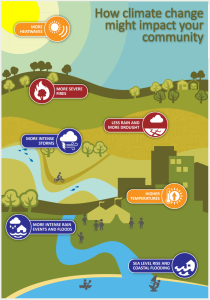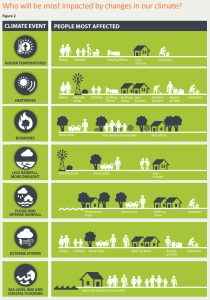1. Climate risk assessment
The first step in taking action to protect lives, property and resources is to identify vulnerabilities and the acceptable level of risk to those vulnerable assets (MRSC Empowering Local Governments). To understand Climate Risk, inform yourself about the risk and likelihood of extreme weather events at the location and region where your organisation, staff and clients are located. Identify the risk likelihood by using the Climate Council’s Climate Risk Map of Australia and the Climate Heat Map of Australia. The Australian Council for Social Services has developed a Disaster Resilience Benchmarking Tool so organisations can assess their current state of preparedness for disasters and emergencies to define areas of improvement.


Source: Red Cross Climate-Ready Communities
2. Determine and understand the climate risks of the people, groups and community you are working with
Historically, marginalised groups are disproportionately affected by climate change, facing heightened risks and challenges in disaster response, recovery, and adaptation efforts. This multifaceted vulnerability is deeply rooted in social, economic, and cultural disparities, making it crucial to address the unique impacts on various historically marginalised communities. One of the critical dimensions of this vulnerability lies in the intersection of climate change disasters with different aspects of human identity and experience. Understanding those realities and the complexities of these intersections is crucial to developing more inclusive and comprehensive approaches to building resilience, ensuring that no one is left behind in the face of our changing climate.
The increased risk of those groups stems not only from disaster events themselves but also from how response and recovery are planned, designed, and delivered.
Determine the climate risks of the people and groups you are working with by including them in Disaster Planning and Preparation and better understanding the Climate Impacts on Social Injustices & Intersectionality.
Visit the resource Climate Impacts on Social Injustices & Intersectionality to find out more about:
- Climate change, disaster and Aboriginal and Torres Strait Islander Peoples and other Indigenous Peoples
- Climate Change, disaster and disability justice
- Climate Change, disaster and older people
- Climate Change, disaster and children and youth
- Climate Change, disaster, climate load and women
- Climate Change, disaster, and culturally and racially marginalised groups (CARM)
- Climate Change, disaster and incarceration
- Climate Change, disaster, poverty and inequity
- Climate Change, disaster and homelessness
- Climate Change, disaster and public housing
- Climate Change, disaster and gender & LGBTIQ+
- Climate Change, disaster and rural communities
- Climate Change, disaster and mental illness
- Climate Change, disaster and parenting
3. Determining the impacts and consequences of disaster on CSOs
The Victorian Council of Social Service outline the anticipated impacts of climate change on Victorian community organisations in their report “A Strong Community Sector for a Safe Climate” as follows:
- Damage to organisations’ assets, including buildings and vehicle fleets;
- Staff being unable to remain safely housed in the local vicinity of their employing organisations;
- Workers are unable to get to work during climate events like bushfires or flooding or even on hotter-than-normal days and
- Reduced ability of staff to visit clients in their home.
- Temporary or permanent reduction in service provision capability: Community organisations may become less resistant to the effects of climate change. Their facilities and personnel may be significantly impacted, potentially leading to an inability to offer services. In severe cases, some organisations might not recover, especially in regions prone to wildfires and flooding.
- Inability to meet rising service demands: Due to climate change impacts, community members will require additional support, which will escalate organisational costs. Limited staffing or financial resources may prevent some organisations from adequately addressing the heightened demand.
- Adverse health and societal consequences for marginalised populations: Service disruptions will negatively affect community members reliant on these services, particularly those facing disadvantages and exacerbated challenges from climate change.
- Damage to reputation: Organisations that fail to deliver services during climate-related disruptions risk losing trust from community members and funding sources.
Read more:
Emerging Minds provides relevant resources and fact sheets.
Climate Vulnerability- Understanding and Addressing Threats to Essential Resources, this resource assesses a broad range of climate change threats using the bottom-up approach. It includes CO2 emissions, population growth, emerging affluence, etc – to the five most critical resources: water, food, ecosystems, energy, and human health. The reference framework helps determine inclusive preventative measures and adaptations.
We aren’t all equal when it comes to climate vulnerability, an interactive map that has measured the level of climate vulnerability in your area.
Fact sheet – Australasia Climate Change Impacts and Risks (Sixth Assessment Report – IPCC)
Climate Council – Projected Heat Map (interactive)

